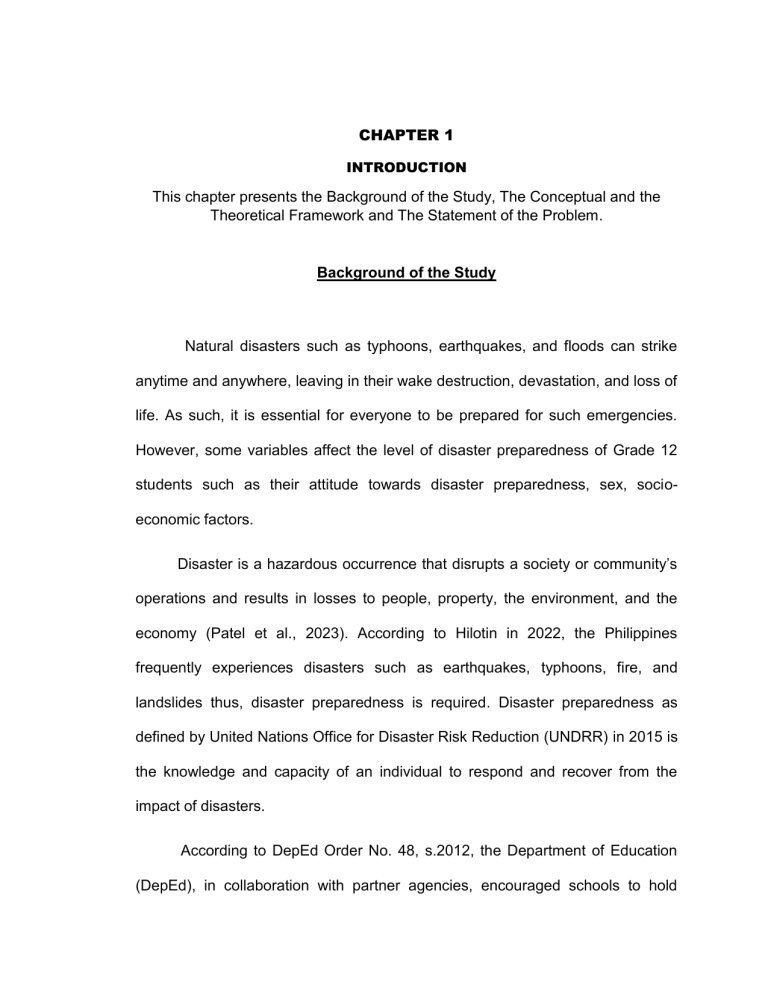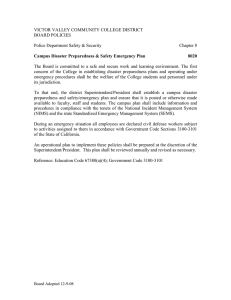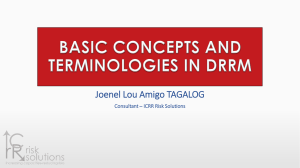
CHAPTER 1 INTRODUCTION This chapter presents the Background of the Study, The Conceptual and the Theoretical Framework and The Statement of the Problem. Background of the Study Natural disasters such as typhoons, earthquakes, and floods can strike anytime and anywhere, leaving in their wake destruction, devastation, and loss of life. As such, it is essential for everyone to be prepared for such emergencies. However, some variables affect the level of disaster preparedness of Grade 12 students such as their attitude towards disaster preparedness, sex, socioeconomic factors. Disaster is a hazardous occurrence that disrupts a society or community’s operations and results in losses to people, property, the environment, and the economy (Patel et al., 2023). According to Hilotin in 2022, the Philippines frequently experiences disasters such as earthquakes, typhoons, fire, and landslides thus, disaster preparedness is required. Disaster preparedness as defined by United Nations Office for Disaster Risk Reduction (UNDRR) in 2015 is the knowledge and capacity of an individual to respond and recover from the impact of disasters. According to DepEd Order No. 48, s.2012, the Department of Education (DepEd), in collaboration with partner agencies, encouraged schools to hold quarterly fire and earthquake drills. “Emergencies and calamities may strike anywhere and anytime. Thus, having an effective preparedness plan is the key in preventing disasters and saving lives,” (DepEd, 2022). The study of Marilou Tan (2019) states that safety facilities and disaster preparedness are crucial in schools to respond to disasters, ensuring a safe place for learners and teachers. Regular exercise of these practices is essential for immediate recovery. Attitude is one of the factors affecting the level of disaster preparedness of students. According to the study conducted by Bhandari and Takahashi (2022) the results shows that the disaster preparedness of the respondents is generally lacking due to their attitude with a mean score of 1.02 (poor attitude). The inadequate readiness of students to face disasters is attributed to the absence of training or orientation provided by the school on appropriate actions during earthquakes. Furthermore, the school has not incorporated earthquake disaster preparedness materials into classroom subjects. The study’s anticipated findings aim to serve as valuable insights for schools, emphasizing the significance of disaster preparedness to mitigate casualties and minimize damages resulting from such disasters (Andespa & Fauzi, 2019). Unexpected events, such as disasters, pose a risk to the school community if they are unprepared and lack the ability to respond effectively. While numerous online studies assess disaster preparedness and knowledge, there is a scarcity of such research specifically focused on senior high school students in the Philippines, given the recent adoption of the senior high school curriculum four years ago. Consequently, this study examines the students’ perception of disaster risk reduction knowledge within the Senior High School department of Eastern Samar State University in the Philippines (Lapada, 2022). Another needed ability during disasters is the resilience skills of students. Resilience is a skill that lessens the effects of such catastrophic scenarios and enhances conditions for both immediate response and long-term planning (Pacheco et al., 2021). In addition, school resilience is referred to as risk-reduction techniques used to establish a secure environment for students in the face of natural disasters. The results of the study conducted by Mirzaei et al. in 2020 imply that location, construction, equipment, architecture, travel routes, education, and function all have a direct bearing on a school’s level of disaster resilience. Moreover, the result of the said study indicates that resilience is influenced by the student’s educational background and the setting of their schools. Despite the fact that various research have been conducted on the level of disaster, there is a shortage of study on the locality of Cordillera Administrative Region (CAR) addressing students’ disaster preparedness. This lack of information limits the understanding of students’ emergency readiness in the locality. Furthermore, the absence of updated literature on disaster preparedness in the Cordillera Administrative Region limits the availability of current information and practices that can help students in the area improve their preparedness level. The study titled ‘’Disaster Preparedness and Awareness among University Students: A Structural Equation Analysis’’ by Patel, R.K. et al. (2023) that is studied internationally only emphasizes the disaster preparedness and awareness of students, not including the disaster resilience of the learners. To have a better understanding, the researchers will study the factors affecting the level of disaster preparedness, awareness, and resilience of senior high school students, This study will be beneficial to students for the reason that it will help in assessing what factors positively or negatively affect their disaster preparedness, awareness, and resilience skills. In addition, identified factors that affect learners will be considered to improve the skills of students during disasters. Furthermore, this study will widen the knowledge of the parents on what factors affect their children's disaster preparedness skills that will help on how they should guide their children to be more skillful during disasters. Lastly, this study will be important to the administration since it will help in monitoring the factors affecting the disaster preparedness of students. This will be vital for the administration in improving the precautionary measures implemented in school regarding disasters. Statement of the Problem The researchers aim to determine the level of disaster preparedness of senior high school students in Baguio City National High School (BCNHS). Specifically, the following questions will be answered: 1. What is the extent of preparation for disaster of senior high school learners? 2. What is the degree of disaster resilience skills of senior high students? 3. What is the degree of awareness of senior high students about disasters?


